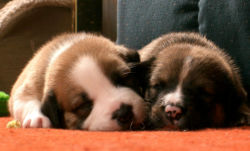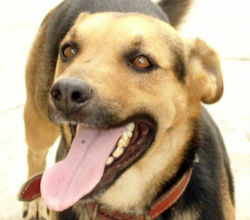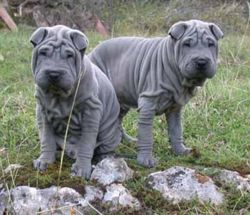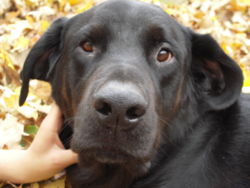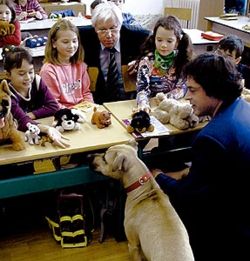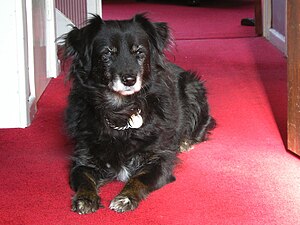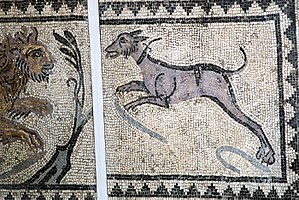Dog/Citable Version
| Domestic dog | ||||||||||||||||||||
|---|---|---|---|---|---|---|---|---|---|---|---|---|---|---|---|---|---|---|---|---|
| Pair of very different dogs ex.Gr.Dane and Chiuaua two breeds of the domestic dog Pair of very different dogs ex.Gr.Dane and Chiuaua
two breeds of the domestic dog | ||||||||||||||||||||
| Conservation status | ||||||||||||||||||||
| Scientific classification | ||||||||||||||||||||
| ||||||||||||||||||||
| Trinomial name | ||||||||||||||||||||
| Canis lupus familiaris |
Domesticated from selected wolves thousands of years ago, the dog is often called "man's best friend". Throughout the world today, dogs are found associated with humans, although certainly not always as a part of the household! Their status ranges all the way from a form of food, to a full-time worker, to a most cherished companion. Perhaps more easily than any other species, dogs communicate with people [1]. On a basic level, dogs and people understand each other: we are able to interpret the dog's instinctive body languag (along with canine vocalizations like the growl and whine); and the dog, in turn, has an inate ability to respond appropriately both to human body language, and to the emotional tone of the human voice. Beyond these basics, people can be educated to more precisely manage their dogs and dogs can be trained to be extremely responsive to people. (see Obedience Training section below).
The domestic life of dogs
Many dog owners view their pets as full-fledged family members, and most dogs are able to act the part. That ability stems from two basic sources: (1) the "hard-wiring" of the dog's behavior (programmed by its canine genes), and (2) the individual dog's experience with people. Dogs are like humans in being highly social animals. Although the instincts to behave in ways that ease interactions in the pack are inborn in all normal dogs, the right early experiences are critical if puppies are to grow up into companiable dogs. Those "right" experiences have everything to do with contact to people and to other dogs, and they must occur early in the dog's life - probably before the puppy reaches 12 weeks of age. In fact, that particular period of time in a puppy's life is actually called the "critical period" or "sensitive period".
When puppies are raised with plenty of close contact to people and to other dogs, they become fully socialized. Socialized pups seem to view their human companions as members of their pack, and make few, if any, distinctions between their owners and fellow dogs. As these puppies mature, they generally learn to modify their behavior towards people, and treat their human companions more gently than their canine ones. Evidence shows that puppies who are raised without human nurturing do not fully adjust to interactions with owners once they have passed the critical period of about 3 months of age, no matter how much gentle attention is then given them. Orphaned puppies who are bottle fed and raised by humans alone, without any contact to any other dog or puppy, are in danger of becoming abnormally fixated on humans, and include animals that turn their sexual attentions, like mounting behaviors, to people instead of to dogs.
Female dogs (called bitches) ordinarily give birth to more than one puppy at a time (sometimes to more than a dozen!). The group of puppies born together is called a litter. In other words, being born in a litter is the natural lot of the dog, and that means most pups are raised in a social group. However, in situations where puppies are isolated from other dogs, and are raised alone, without experiences in canine society, they can fail to learn the give and take of normal puppies. That's one reason that the dog or older puppy adopted from a shelter or obtained from a private seller can pose problems to a new owner. Brought out on a leash in streets where other dogs go by, or let off a leash in a dog park or outdoor space where other dogs are free, a poorly socialized dog may attack other dogs out of fear. Once grown, such pups most often can never be successfully integrated into a group of dogs.
Dogs fill a variety of roles in human society and are often trained as working dogs. Thousands of dogs throughout the world actively herd sheep and cattle, guard people and property, and guide the blind and disabled. Dogs are an important part of rescue work in disasters. Their noses aid police and military searches for weapons, drugs, and other contraband. The most common (and perhaps most important) role of dogs in many countries is as a human companion.
Dog breeds
Dogs have an enormous range of normal height and lean weight. The smallest of the breeds is the Chihuahua, and the largest, the Great Dane. Despite the great differences in size between these two extremes, both the Chihuahua and the Great Dane are the same species and can interbreed successfully! Dogs also have an incredibly broad range of fur and skin colors and patterns, skull and face shape, hair length and texture, tail shape and carriage, athletic ability and temperaments. All of these, along with other physical characteristics, are influenced by inherited genes. Even certain specific complex behaviors ( like pointing, or retrieving) appear to be inherited in dogs. The gene pool of domestic dogs is anything but monotonous!
Just as one individual animal might have a combination of traits that causes that particular dog to appear so entirely different from another, there are diverse breeds of dogs, where each breed includes dogs that are very similar to each other, but clearly distinct from the dogs of a different breed. Through the years, by concentrating particular genes and reducing other ones, Dog breeds have developed in which each group of individuals share a recognizeable "brand" of canine style, from size, to fur, to snout, to bark.
Purebred dogs are breeds that have been selected to "breed true". That means that a good example of a pure bred (pedigreed) dog looks like its kind in physical appearance, and acts like its kind in temperament and certain behaviors. Generally, two purebred parents of the same breed will always produce a litter of pups that will grow up to be quite like them in looks, temperament, and behavior. The two Chinese Shar pei youngsters pictured at left show the famously loose and wrinkled skin of their breed, but there are many more characteristics that typify that breed, ranging from a blue-black tongue to a calm, confident stance.
Registered Purebred Breeds
Presently, over over 800 dog breeds are recognized by kennel clubs worldwide. Dogs can be registered with a club and receive papers that indicate a purebred pedigreed status. In order to qualify for registration, a purebred puppy must have two registered parents of the same breed, and meet the breed standard: a written description of a certain "look" (physical conformation) and other features. This breed standard specifies what features are acceptable, which are preferred, and, sometimes, specifies particular features that, if present, disqualify the dog from being shown as a proper representative of its kind. And so, in the AKC, a bulldog puppy might have the face, ears, stance and size of its breed, along with a host of other proper features, and been born of two AKC registered bulldogs- but is disqualified by a "brown or liver-colored nose" [1].
Each large kennel club hosts dog shows in which points are given for how well an individual dog compares to the breed standard, as compared to others of its type displayed at the same show. The male and female dogs competing in the top kennel clubs must be unneutered ("entire") animals and, although the gait and demeanor of the dog is evaluated as each walks around the show ring, the major emphasis is on body features. These contests are sometimes called conformational shows. Male and female dogs earning their championships and higher awards, such as grandchampionships, in dog shows have demonstrated that they possess the desired qualities of their breed. Purebred puppies who have champions and grandchampions in their pedigree generally command a higher price. Not all breeders are involved in showing dogs, but all ethical breeders try to "better the breed" by producing puppies from parent dogs who are true to the breed's type and who do not possess severe faults.
Although kennel clubs like the American Kennel Club (AKC) heavily stress physical features, many AKC breed standards specify a general temperment. For example, in the case of the Labrador Retriever, a friendly temperament is so important that showing aggression to a person or another dog is listed as a major fault . Kennel Clubs exist in many countries throughout the world. In some countries, there are several clubs. The Breed standard for each Breed is given by each club, and though the standards are similar - they are not the same. For example, the Border Collie is defined one way by the Kennel Club in Britain [2], and in a slightly different way by the AKC in the United States [[3]]
Other breeders concentrate on achieving uniform inherited behavioral traits in the dogs they produce, and consider conformational traits important - but secondary. Working, hunting, and herding dogs raised by field breeders sometimes only generally resemble the breed standard in appearance, but are more likely to be consistent in doing the job. The phrase "that dog don't hunt" comes from the rural United States and refers to a hunting dog that lacks the finer instincts of its breed.
Natural breeds
In some parts of the world the isolation of dogs by geography (islands, mountain passes) has produced so-called natural breeds. These dogs are largely the product of natural selection. Members of a natural breed breed true - adults are similar to each other in appearance and behavior, and produce litters of puppies that not only grow up to resemble their parents, but - once grown, can between themselves propogate more litters of the breed.
Sometimes these natural breeds have also undergone selective breeding by humans who desired a certain type of working dog. Such ancient working breeds include the Greyhounds, the Mastiff and the Anatolian Shepherd. Natural breeds made up many of the very first of the registered breeds, and also include some of the most recent additions to the list of breeds registered by kennel clubs. The Shar pei is a natural breed, "having existed for centuries in the southern provinces of China, apparently to the Han dynasty, circa 200 BC". reference for quote: Chinese Shar-Pei in The Complete Dog Book, Official Publication of the American Kennel Club, 20th Edition, Ballantine Books, New York, 2006,page 543. Despite the fact that statues of dogs that look just like the Shar-pei date back to the Thirteenth Century, the breed was not actually registered until the later part of the Twentieth Century (initially by the Hong Kong Kennel Club). Other natural breeds have never been recognized formally by any kennel club.
Crosses
There are modern dog breeders who purposely mate dogs of two completely different breeds in order to produce a litter of puppies with a set of desired characteristics that are not present in either parent. These crosses are sometimes called "a breed", but do not fulfill the requirement of "breeding true". For example, a pure bred Poodle and pure bred Cocker Spaniel, if crossed, usually will produce a litter of puppies that all look very much alike. This particular cross has the name Cockapoo. The poodle is one parent of another popular cross, the Labradoodle, in which the other parent is a Labrador Retriever. Why choose the poodle for cross breeding? The poodle's unique coat does not shed. This quality reduces both housecleaning requirements and dog allergy symptoms in owners, and is one of the reasons prompting both crosses (see Choosing a dog - Allergy).
Although the hybrid puppies in the cross between two pure breds (sometimes called the F1 generation) often all look alike, these puppies cannot grow up and be mated to other dogs that were born of the same crossed parentage and reliably produce new puppies that are like them. If a breeder does mate a mother from one of these crosses (let's say Cockapoo) to a father dog who is also a first generation Cockapoo, a few of their puppies may have the desired set of qualities - but sometimes none will, and often those few that do are in the minority of a large litter. This leaves several puppies who are mixed breed dogs (see below), and at high risk for joining their brethren in the shelters and streets of the world as unwanted pets. However, if the breeder continues to work with such a cross over many generations - being careful not to often mate individuals who are immediately related to each other (inbreeding) in order to avoid bringing out harmful recessive traits that cause disease, eventually healthy dogs may be produced who do, in fact, breed true. Once such crosses can be bred so that all members of a litter reliably resemble the breed standard, then a new purebred breed has become established, and fanciers usually campaign to have it recognized by a kennel club.
Although crosses between purebreds have been used (along with mixed breed crosses) to establish most of the long recognized dog breeds, many animal welfare advocates have openly deplored this method for any current propogation of a new breed. That's because it necessarily produces generations of mixed breed puppies in a world where there is already a great overpopulation of such dogs. The breeders Cockapoos and Labradoodles, however, counter that development of a new breed is a worthy goal, and that, with ethical breeding practices, all puppies can be properly placed.
Mixed breeds (mongrels)
Dogs who came from parents who were not of any breed, or more than one breed, are called mixed breed. There are many other names for them, and some are not very polite. Even the word, mongrel, which is one of the most common names given them, is considered insulting by some dog lovers. That's probably because, in the English language, this word has sub-meanings that imply a lesser worth. However, it is fair to say that all dogs are derived from mongrels, and that, far from having a lesser worth, mixed breed dogs may well offer their owners "the best of everything" having to do with dogs.
Behavior and skills
Both anecdotal evidence and scientific research suggest that dogs have a reasonably high intelligence. This intelligence is expressed differently in different breeds and individuals, along with sets of specific behaviors and talents that appear to be inherited.
For example, Border Collies are noted for their ability to learn complex commands on dry land, while Newfoundland Dogs are known as powerful swimmers who can be trained to rescue the drowning. There are many breeds of retrievers, all of them share the propensity to not only chase that ball (or rabbit) but to bring it back. In the days when retrievers were all hunting dogs, only those animals that were excellent fetchers were bred, the puppy who might be beautiful and affectionate, but who remained totally uninterested in delivering the goods, was not propogated. One criticism lodged at breed registries such as the American Kennel Club is that success in the showring is based on conformation rather than on working ability. The AKC does sponsor field trials, however, for working and hunting dogs. If a retrieving retriever is what's wanted, the person shopping for a puppy might be advised to look for field championships in the puppy's pedigree, and not just awards for body type. On the other hand, though more likely to have the skill, a puppy born of even the great retrievers may not itself be inclined to retrieve.
Some of the individual dogs who most easily learn complex tasks are among the most difficult dogs to integrate into a normal household. Border collies are an excellent example of a breed that is both known for its intelligence and for its over-representation in animal shelters, as are Jack Russell terriers. When typical of their breed, these dogs are not suitable for a household where no one is home for hours at a time and no barn or other work is available for the dog. Like all dogs who are both "high energy" and high in canine intelligence, these two breeds are examples of those that usually require a great deal of attention and do best when kept busily engaged. When left alone for hours at a time, they are very unlikely to curl up and go to sleep. Especially when young, smart, high energy dogs are more likely to dismantle the furniture, if left inside the house or apartment, or testing a prize horse's capabilty of jumping out of its fenced pasture, if left to wander free out in the country.
Health, Care, and Breeding of Dogs
Modern dog breeds show more variation in size, appearance, and behavior than any other domestic animal. When choosing a dog, these factors are all best taken into consideration along with the particular animal's age, circumstances, and background.
Within the range of extremes, dogs generally share attributes with their wild ancestors, the wolves. Dogs are both predators and scavengers, possessing sharp teeth and strong jaws for attacking, holding, and tearing their food. Although selective breeding has changed the appearance of many breeds, all dogs retain basic traits from their distant ancestors. Like many other predatory mammals, the dog has powerful muscles, fused wristbones, a cardiovascular system that supports both sprinting and endurance, and teeth for catching and tearing. Compared to the bone structure of the human foot, dogs technically walk on their toes.
Sight
Because the lenses of dogs' eyes are flatter than humans', they cannot see as much detail; on the other hand, their eyes are more sensitive to light and motion than humans' eyes. Some breeds, particularly the best sighthounds, have a field of vision up to 270° (compared to 180° for humans), although broad-headed breeds with their eyes set forward have a much narrower field of vision, as low as 180°.[2][3]
Hearing
Dogs detect sounds as low as the 16 to 20Hz frequency range (compared to 20 to 70 Hz for humans) and as high as 70 kHz to 100 kHz (compared to 13 to 20 kHz for humans)[3], and in addition have a degree of ear mobility that helps them to rapidly pinpoint the exact location of a sound. Eighteen or more muscles can tilt, rotate and raise or lower a dog's ear. The dog's sensitivity to even very quiet sounds, as compared to a human, means that a dog can identify a sound's location much faster, as well as hear sounds that are coming from far more distant sources than a human companion by its side.
Those with more open ear shapes, like the erect ears of wild canids like the fox, generally hear better than those with the floppier ears of many domesticated species.
Smell
Dogs have nearly 220 million smell-sensitive cells over an area about the size of a pocket handkerchief (compared to 5 million over an area the size of a postage stamp for humans). It is fair to say that all dogs have a rich sensory experience in olfaction, as compared to ours. Some breeds have been selectively bred for excellence in detecting scents, over and above their canine brethren. Blood hounds
Diet
At present, there is some debate as to whether domestic dogs should be classified as omnivores or carnivores, by diet. The classification in the Order Carnivora does not necessarily mean that a dog's diet must be restricted to meat; unlike an obligate carnivore, such as the cat family with its shorter small intestine, a dog is dependent on neither meat-specific protein nor a very high level of protein in order to fulfill its basic dietary requirements. Dogs are able to healthily digest a variety of foods including vegetables and grains, and in fact can consume a large proportion of these in their diet. Wild canines not only eat available plants to obtain essential amino acids, but also obtain nutrients from vegetable matter from the stomach and intestinal contents of their herbivorous prey, which they usually consume. Domestic dogs can thrive on a reasonable and carefully designed vegetarian diet, particularly if eggs and milk products are included. Some sources suggest that a dog fed on a strict vegetarian diet may develop dilated cardiomyopathy since it lacks L-carnitine, [4] however, maintaining a balanced diet is also a factor since L-carnitine is found naturally in many nuts, seeds, beans, vegetables, fruits and whole grains. In the wild, dogs can survive on a vegetarian diet when animal prey is not available. However it has been noted, both by observation of extremely stressful conditions such as the Iditarod race and by scientific studies of similar conditions, that high-protein (approximately 40%) diets including meat help prevent damage to muscle tissue. This level of protein corresponds to the percentage of protein found in the wild dog's diet when prey is abundant; higher levels of protein have not been proven to add a benefit.
Dogs often eat grass, sometimes avidly. This is a harmless activity, and although it may be important for health, the role of grass in the canine diet is unknown. Some people claim that grass might neutralize excess stomach acid, others suggest that eating grass prompts the dog to vomit, and so dogs eat grass to remove unwanted substances from their stomachs. Dogs do vomit more readily than humans, as part of their typical feeding behavior of gulping down food then regurgitating indigestible bones, fur, etc. This behavior is typical of pack feeding in the wild, where the most important thing is to get as much of the kill as possible before others consume it all. Individual domestic dogs, however, may be very "picky" eaters, in the absence of this evolutionary pressure.
Most standard dog care guides stress that dogs should not be fed table scraps, but be only be fed a high quality commercial dog food.
Just as there are schools of thought about human diet, with advocates of various strict regimens ranging from macrobiotics to raw foods, there are a number of diets recommended for dogs that involve an entire philosophy of dog health. There are breeders who insist that puppies purchased from them be maintained on particular diets, and, generally, their wishes should be respected.
When purchasing a puppy from a breeder, or adopting from a shelter, it is wise to find out the diet that the animal has been maintained on, and to make only gradual changes.
Dog health
- Further information: Category:Dog health
Dogs are susceptible to various diseases, ailments, and poisons, some of which affect humans in the same way, others of which are unique to dogs. Dogs, like all mammals, are also susceptible to heat exhaustion when dealing with high levels of humidity and/or extreme temperatures.[5]
Diseases
Infectious diseases commonly associated with dogs include rabies (hydrophobia), canine parvovirus, and canine distemper. Congenital diseases of dogs can include a wide range from hip dysplasia and medial patellar luxation to epilepsy and pulmonic stenosis. Canines can get just about anything a human can get (except the many infections which are species specific) like hypothyroidism, cancer, dental disease, heart disease, etc.
Vaccinations
Parasites: Treatment and Prevention
Common external parasites are various species of fleas, ticks, and mites. Internal parasites include hookworms, tapeworms, roundworms, and heartworms.
Some breeds of dogs are especially prone to certain genetic ailments, such as hip dysplasia, luxating patellas, cleft palate, blindness, or deafness. Dogs are also susceptible to the same ailments that humans are, including diabetes, epilepsy, cancer, and arthritis. Gastric torsion and bloat is a dangerous problem in some large-chested breeds.
Almost every breed of dog has an organized group of fanciers promoting it. Doing an internet search on the breed will yield a number of breeder sites, along with the various fanciers' organizations' web sites. Usually, one or more of the sites will list not only the attributes that are wonderful features of the breed, but any special health problems along with information for diagnosis and treatment.
Lifespan
The typical lifespan of dogs varies considerably by breed, and seems to be somewhat related to size. For example, many giant dog breeds average only 7 or 8 years, while some small terrier breeds might live as long as 20 years.The average lifespan for mixed-breed and midsize dogs is about 13 to 14 years. The longest-lived dog with reliable documentation died at 29 in 1939.
Obedience Training
- For details, see Category:Dog training and behavior.
Overpopulation
According to the Humane Society of the United States, 3-4 million dogs and cats are euthanized each year in the United States and many more are confined to cages in shelters because there are many more animals than there are homes. Spaying or neutering dogs helps keep overpopulation down.[4] Local humane societies, SPCA's and other animal protection organizations urge people to spay or neuter their pets and to adopt animals from shelters instead of purchasing them.
Ancestry and history of domestication
Molecular systematics indicate that the domestic dog (Canis lupus familiaris) descends from one or more populations of wild wolves (Canis lupus). As reflected in the nomenclature, dogs are descended from the wolf and are able to interbreed with wolves.
The earliest dog fossils, two crania from Russia and a mandible from Germany, date from 13,000 to 17,000 years ago. Their likely ancestor is the large northern Holarctic wolf, Canis lupus lupus. Remains of smaller dogs from Mesolithic (Natufian) cave deposits in the Middle East, dated to around 12,000 years ago, have been interpreted as descendants of a lighter Southwest Asian wolf, Canis lupus arabs. Rock art and skeletal remains indicate that by 14,000 years ago, dogs were present from North Africa across Eurasia to North America. Dog burials at the Mesolithic cemetery of Svaerdborg in Denmark suggest that in ancient Europe dogs were valued companions.
Genetic analyses have so far yielded divergent results. Vilà, Savolainen, and colleagues (1997) concluded that dogs split off from wolves between 75,000 and 135,000 years ago, while a subsequent analysis by Savolainen et al. (2002) indicated a "common origin from a single gene pool for all dog populations" between 40,000 and 15,000 years ago in East Asia. Verginelli et al. (2005), however, suggest both sets of dates must be reevaluated in light of recent findings showing that poorly calibrated molecular clocks have systematically overestimated the age of geologically recent events. On balance, and in agreement with the archaeological evidence, 15,000 years ago is the most likely time for the wolf-dog divergence.
Verginelli examined ancient DNA evidence from five prehistoric Italian canids carbon-dated to between 15,000 and 3,000 years old, 341 wolves from several populations worldwide, and 547 purebred dogs. Their results indicate multiple independent origins of dogs and/or of frequent interbreeding between early proto-dogs and wolves throughout a vast geographic range. The detailed history remains unexplored and until further evidence is available, the following section on wolf ancestors must be considered purely speculative.
Wolf ancestors
Although all wolves belong to the species Canis lupus, there are (or were) many subspecies that had developed a distinctive appearance, social structure, and other traits. For example, the Japanese Wolf and the Eastern Timber Wolf possess different distinctive coloration, hunting and social structures. The Indian Wolf is thought to have contributed to the development of more breeds of dogs than other subspecies. Many of today's wild dogs, such as the dingo and the pariah dogs, are descended from this wolf.
The Indian Wolf is also thought to have bred with descendants of the European wolf to create the Mastiffs and eventually leading to the development of such diverse breeds as the Pug, the Saint Bernard, and the Bloodhound. The Tibetan Mastiff is an example of an ancient breed.
The European wolf, in turn, may have contributed many of its attributes to the Spitz dog types, most terriers, and many of today's sheepdogs. The Chinese wolf is probably ancestor to the Pekingese and toy spaniels, although it is also probable that descendants of the Chinese and European wolves encountered each other over the millennia, contributing to many of the oriental toy breeds.
The Eastern Timber Wolf is a direct ancestor to most, if not all, of the North American northern sled dog types.
Dog/Wolf Hybrids
In the wild, in areas where wolves still roam but the human population is also established, there is the occaisional inter-breeding of wolf and dog. Since a wolf pack is not likely to perceive a dog as anything but prey, and a domestic dog is unlikely to survive attack from even a lone wolf, this is not as common as the interbreeding of dogs and coyotes in similar circumstances. When dogs and coyotes do interbreed in the wild, the resulting hybrids often fail to thrive because they lack behavior features of the wild canine parent. For example, the domestic bitch ordinarily comes into heat twice or more times a year, where as the coyote female is fertile only once a year. The timing of the dog's estrus does not correspond to the local seasons in a way that is advantageous to a newborn litter, and so puppies born in the lean times of winter or drought are more likely to die. The instinct to only allow one mating pair of animals in the pack and the nurturing instincts of other pack members towards their pups, including the males, is almost completely lost in the dog; and so hybids in the wild are less able to raise litters that survive.
In human society, there are people who selectively breed wolves and dogs as pets. Currently, in many areas, there are laws against keeping wolves in captivity, but there are regions where this is not the case. Often, the breeder of these hybrids works not from full wolves, but selects a hybrid wolf/dog as one parent, and either another hybrid or a domestic dog as the other parent.
Molecular genetic research has shown that dogs appear to have been domesticated from wolves, but not from wolves in general - instead, selected individual ancient wolves were kept and interbred. There is speculation that among the wolves that harried these early human settlements or frequented ancient dumps, the particular individuals chosen for "adoption" by people were probably not only very young - but were exceptionally "nice". There is variation in behavioral characteristics in every large group of wolves, and it is not likely that the wild wolf pup who is at the extreme for aggressiveness, for example, would be tolerated in human society - once grown into an adult wolf, even if originally adopted in its infancy.
That has been the overall situation with wolf/dog hybrids. Breeders of these hybrids routinely remove the puppies from the mother by 2-3 weeks of age, and hand raise them, bottle feeding the puppies every few hours. Each puppy is allowed contact with at least one other puppy, but all puppies are kept isolated from adult dogs and wolves (including their own mother) because if they are allowed contact they usually will not bond to their human handlers. Even then, and even though these hybrid puppies are usually much less than 50% wolf, there is an extremely high rate of attacks on humans by adult hybrid wolf/dogs - including the members of the human family that raised them. Breeders of hybrid wolf/dogs counsel that these dogs must at all times be fenced off from any possible contact with strangers [5]. Fatal human attacks by hybrids are not rare, and often victimize children.
==Dogs in the wild==
Feral dogs
Notable Dogs
Many dogs have earned a level of fame, to the point where the name of the animal has become recorded in history. None of the following dogs are fictional, and each of them helps illustrate the range of accomplishments of working and companion dogs.
Barry: Buried in an island graveyard in the River Seine in Paris, lies this Newfoundland dog who patrolled the St. Bernard Pass in the Swiss Alps. The monument depicts him saving a child, and in fact he saved the lives of forty people, lost in snowstorms in those mountains.( ref <A Hero DogThe Watchman (1894-1906). Boston: Nov 8, 1900. Vol. 81, Iss. 45; p. 22 (1 page) >
Balto (1922 – March 14, 1933) was a lead sled dog in the 1925 serum run to Nome, in which diphtheria antitoxin was transported from Anchorage, Alaska to Nome by dog sled teams to combat an outbreak of the disease. Balto and his team became famous during coverage of the event, and went on to tour the country before being placed in a Cleveland Zoo.
Brandy: was the first "seeing-eye dog" in the United States. Although guide dogs for the blind had become accepted in Germany in the early Twentieth Century, American organizations for the blind scorned their use." (reference for quote: Brandy Chapter in Dog Heroes, Tim Jones, Epicenter Press, Seattle, 1995 page 37) The head of one prestigious school for the blind described the guide dog as 'a dirty little cur dragging a blind man along at the end of a string, the very index of incompetence and beggary." A young American blind man, Morris Frank, fought for a full and independant life at a time when this was not considered possible for a person like him. He travelled to Switzerland, at the invitation of the trainers Dorothy Eustis, and there went through an extensive course of training with a German Shepherd bitch he named "Brandy". He returned to New York City and, in the glare of flashbulbs, showed reporters that he, a blind man, could walk (with Brandy) across some of the busiest and most dangerous streets in the city. His subsequent travels across the country demonstrated that a blind person could be guided by a dog and achieve independence.
References
- ↑ Stephen Budiansky, The Truth about Dogs: An Inquiry into Ancestry Social Conventions Mental Habits Moral Fiber Canis familiaris. 2001 ISBN 014100228X
- ↑ Cite error: Invalid
<ref>tag; no text was provided for refs namednote1 - ↑ 3.0 3.1 Cite error: Invalid
<ref>tag; no text was provided for refs namednote2 - ↑ Small animal internal medicine, RW Nelson, Couto page 107
- ↑ Gedon, Trisha (2006-05-25). Summer heat can be tough on pets. Division of Agricultural Sciences and Natural Resources. Oklahoma State University. Retrieved on 2006-08-21.
Further reading
- Brewer, Douglas J. (2002) Dogs in Antiquity: Anubis to Cerberus: The Origins of the Domestic Dog, Aris & Phillips ISBN 0-85668-704-9
- Coppinger, Raymond and Lorna Coppinger (2002). Dogs: A New Understanding of Canine Origin, Behavior and Evolution, University of Chicago Press ISBN 0-226-11563-1
- Cunliffe, Juliette (2004). The Encyclopedia of Dog Breeds. Parragon Publishing. ISBN 0-7525-8276-3.
- Derr, Mark (2004). Dog's Best Friend: Annals of the Dog-Human Relationship. University of Chicago Press. ISBN 0-226-14280-9
- Donaldson, Jean (1997). The Culture Clash. James & Kenneth Publishers. ISBN 1-888047-05-4 (paperback).
- Fogle, Bruce, DVM (2000). The New Encyclopedia of the Dog. Doring Kindersley (DK). ISBN 0-7894-6130-7.
- Grenier, Roger (2000). The Difficulty of Being a Dog. University of Chicago Press. ISBN 0-226-30828-6
- Milani, Myrna M. (1986). The Body Language and Emotion of Dogs: A practical guide to the Physical and Behavioral Displays Owners and Dogs Exchange and How to Use Them to Create a Lasting Bond, William Morrow, 283 pages. ISBN 0-688-12841-6 (trade paperback).
- Pfaffenberger, Clare (1971). New Knowledge of Dog Behavior. Wiley, ISBN 0-87605-704-0 (hardcover); Dogwise Publications, 2001, 208 pages, ISBN 1-929242-04-2 (paperback).
- Savolainen, P. et al. (2002). Genetic Evidence for an East Asian Origin of Domestic Dogs. Science 298. 5598: 1610–1613.
- Shook, Larry (1995). "Breeders Can Hazardous to Health", The Puppy Report: How to Select a Healthy, Happy Dog, Chapter Two, pp. 13–34. Ballantine, 130 pages, ISBN 0-345-38439-3 (mass market paperback); Globe Pequot, 1992, ISBN 1-55821-140-3 (hardcover; this is much cheaper should you buy).
- Shook, Larry (1995). The Puppy Report: How to Select a Healthy, Happy Dog, Chapter Four, "Hereditary Problems in Purebred Dogs", pp. 57–72. Ballantine, 130 pages, ISBN 0-345-38439-3 (mass market paperback); Globe Pequot, 1992, ISBN 1-55821-140-3 (hardcover; this is much cheaper should you buy).
- Thomas, Elizabeth Marshall (1993). The Hidden Life of Dogs (hardcover), A Peter Davison Book, Houghton Mifflin. ISBN 0-395-66958-8.
- Verginelli, F. et al. (2005). Mitochondrial DNA from Prehistoric Canids Highlights Relationships Between Dogs and South-East European Wolves. Mol. Biol. Evol. 22: 2541–2551.
- Vilà, C. et al. (1997). Multiple and ancient origins of the domestic dog. Science 276:1687–1689. (Also "Multiple and Ancient Origins of the Domestic Dog")
- Small animal internal medicine, RW Nelson, Couto page 107
